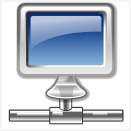Author's Note: This is the beginning of a 3 part series I'm writing that chronicles the origins of this site and the simultaneous rise of OSx86. In keeping with our community spirit, I'd love to read your early experiences with OSx86 as well... just jump right in this thread. Thanks, and enjoy. - Jason Swadley
A History of OSx86 - Part I
A New Hope.
I consider myself the quintessential 'switcher.' My journey to OS X began with an early frustration with Windows, a new iPod, and an infatuation with gorgeous Macs. I came to the Macintosh by way of a little thing that came to be known as OSx86, and its story is one of intrigue and hacking the likes of which hadn't been seen since the beginning of the PC age. This is the tale of how OS X came to the PC and, in doing so, changed computing history. I didn't sleep much in those days - and I've slept a lot since then - but I humbly present a chronicle of the story as I recall it.
For me, OSx86 began in June of 2005. Rolling out of bed on the 6th, I plopped down at my PC to get my morning tech news fix. The top story: Steve Jobs (a name I vaguely knew) had just announced that the entire line of Macintosh computers would be transitioning from PowerPC processors to those made by Intel. At first I was shocked. A year or so before, I had done some searching on installing OS X on PCs. I loved the Dock and couldn’t find a suitable replacement for Windows at the time. I quickly discovered that the main roadblock to running OS X on a generic PC was the different processor architecture, which wasn't changing anytime soon. I forgot the idea and filed it away under "Wishful Thinking."
But then came June. That morning I was reminded of my earlier question - why can't I install OS X on my PC? If the answer had been processor architecture, and that architecture was changing, surely we would soon be able to buy OS X for PCs! Wouldn’t that be great!
As the summer listlessly passed, however, it became clear that Apple had no intention of selling OS X for my Dell. Those long hot days of June also revealed a large interest among geeks in having Aqua on a generic PC. Blogs everywhere were wondering if a leaked version of the Intel developer build could be run on a PC. Several posted rumors about leaked developer disks from WWDC. This is where my story begins.
Although I consider myself quite competent with computers, I'm certainly not a hacker. I was curious about OS X since it offered the stability of Unix without having to learn command line. That June no one knew anything - whether a disk would be installable on any PC, whether it would be traceable to a specific developer who leaked it, or how Apple would manage the transition. All we knew was that we wanted to get our hands on it to try.
A random blog comment mentioned that a leaked x86 installation disk had been posted to Demonoid. Although the comments on Demonoid proved the first archive was a hoax, links in the comments sent me to a site linking to a site that linked me to the IRC channel of osbetaarchive.org.
By this time there were a number of nicknames floating around for the Intel version of OSx86, with none gaining universal usage. Some called it "mactel," others "macintel" or "OSx86," a combination of OS X and the x86 processors on which it would now run. The IRC gang began calling it OSx86, which didn't have the "hacking" connotation it does today. Since this was my only real interest on IRC, and since the folks in the main osbetaarchive channel had other things they wanted to talk about, I launched #osx86 for discussion solely about the new Intel OS X. I had no idea where "/join #osx86" would take me. This is where The OSx86 Project, and then InsanelyMac, began.
In July of 2005, an archive was posted onto Demonoid called "mactel.tar" that supposedly contained files smuggled off an Intel developer machine (DevKit or DTK in the lingo of those first few months) at WWDC. The excitement was palpable. The numbers in the IRC channel swelled as several developers and hackers began to dissect the "mactel" files. While incomplete for a pure installation, several folks began working on combining those files with files from a stock Darwin installation in order to get a working copy of OSx86.
It was becoming clear that IRC was not the best medium for the discussion of everything we were learning about OS X for Intel - there were no archives, communication had to be in real time, and longer-term conversations were very difficult. After discussing the matter with a friend named Shuddertrix, I realized that we needed a wiki for folks to post their knowledge and other interesting information. We set up the wiki at osx86.classicbeta.com and it quickly became the central repository for all information relating to OSx86.
About this time, the devs working on the mactel.tar files made an interesting discovery – the Intel version of OS X routed many important Rosetta system calls through a Trusted Platform Module (TPM) chip. It was the act of posting this news on our wiki that launched what can only be called the OSx86 revolution. What began with digg soon spread to Slashdot and others, bringing visitors by the thousands to our website, all curious about the possibilities of installing OS X on their PCs. Having just launched a tiny forum a few weeks earlier, we were amazed at the number of people who joined. OSx86 was truly becoming a phenomenon.
On July 30, 2005, the first OSx86 installation disk was leaked. Here's what I posted on the wiki (which was our news page) at the time:
The intimate details of that leak weren't known to many. Rampant speculation was that Apple leaked it intentionally, and while that would make for a much better story, it wasn't the case. An IRC chap who we’ll call ColdKill had contacted someone from a random forum who mentioned that his corporation (a large Silicon Valley firm we've all heard of) had purchased a DevKit. ColdKill asked for a copy of the install disk and the developer agreed. The developer called the disk image "Marklar" after the codename of Apple's Intel project from previous years. After agonizing days of slowly downloading the image via FTP, ColdKill brought together a handful of IRC friends to help release a torrent; the idea being that the more people who could eventually access the files, the quicker it would be cracked.
One of the funny things about that initial leak was the format - the developer who leaked it, being a Mac user, ripped the disk into a .dmg file. Since all the would-be hackers weren’t using a Mac yet, this presented a problem. Hours were spent trying to convert the file using a Windows program until someone finally discovered one that worked. The hackers were ecstatic and immediately began dissecting the contents.
The files for a complete OS X installation were now available to anyone - the trick would be creating a working copy. A community was beginning to form, and it would only be a matter of days until the beauty of Aqua first graced the monitor of a PC.
Stay tuned for A History of OSx86, Part II later this week...









Recommended Comments